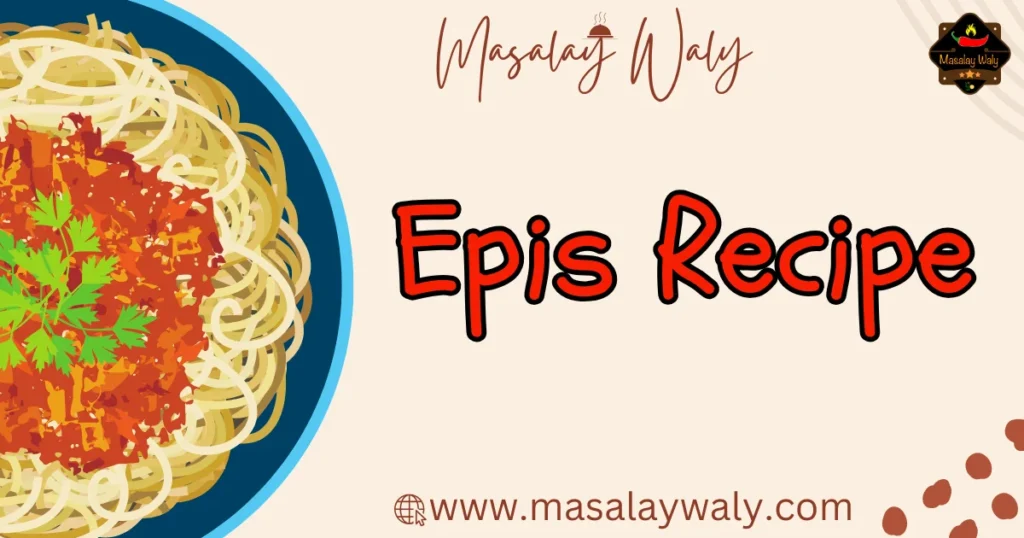At the heart of Haitian cooking is Epis Recipe – a seasoning which is a mixture of spices, generally a blend of herbs that are a signature to a majority of the Haitian dishes. This rub does not simply add flavor a dish; it is a one-stop solution for all kinds of culinary preparations, including soups, stews, meats, and rice. Epis is a marinade, a base for seasonings and spices, and a flavoring ingredient that speaks the language of Cuban culture: strength, powerful herbs, bright fresh flavors. A spice blend that maximizes herbaceous and aromatic integrity in every dish while delivering a well-balanced and consistent taste.
History of Epis: A Dish That Got Many Generations of People Hooked & Happy!
Epis’s Heir of the Nations is centered on Haiti’s cultural scope that has influences from Africa, France, Taino and Spanish- speaking communities. In the past, people in the households would harvest large portions of epis so that they can be used throughout the week. This was done to ensure that the meals were always cooked with proper spice and flavor. Today’s recipe specifies the use of several herbs and peppers which shape the profiles unique to the area. The variants aside, * epis remains indispensable in the preparation* of haitian dishes such as griot, soup joumou and diri ak pwa.
What Goes on an Epis and What is Ideal?
Almost every ingredient used in Epis has a specific purpose which helps to enhance its smell and flavors. Below are the basic ingredients used but you can modify them to your liking:
- One whole onion – Melows the taste and gives it weight
- 2-3 scallions (green onions) – Adds a milder flavor that is slightly earthy
- 1 green bell pepper – Contributes some strong green traces
- 1/2 red bell pepper – Includes some colorful notes and hint of sweetness
- 1 bunch of freshly acquired parsley – Contributes to the freshness of the herbaceous flavor
- 6-8 garlic cloves – Very necessary indeed for its pungent and potent aroma
- 1 tablespoon thyme leaves – Sour and earthy herbal nuances of classic culinary herb
- 1 or 2 scotch bonnet peppers. It is optional – It will add some heat and hot kick
- 1/4 cup olive oil – Binds the ingredients and increases its shelf life
- Juice of 1 lime – Imparts a strong sourness to blend in the mix
- 1 teaspoon salt – It is great for emphasizing all flavors
- 1/2 teaspoon black pepper – For a slightly hotter flavor
- 1/4 cup white vinegar – To give a touch of sweetness and preserve the paste

Making Authentic Epis Step By Step Process
Step 1: Focus on Vegetables and Herbs
- Firstly, cut the onion, scallions, and green and red bell peppers and parsley into larger chunks as well. Do not stress out if the pieces are not all identical as they will be blended later anyway.
- Get the peeled garlic cloves along with thyme leaves ready for the preparation of the mix.
Step 2: Incorporate Heat with Scotch Bonnet Peppers (Optional)
- If a hot Epis is your type, deseed about 1-2 Scotch bonnet peppers and roughly chop them. If not, skip the use of peppers altogether or use half of one.
Step 3: Combine the Ingredients to Make Epi Smooth Paste
- In a food processor or blender, mix the chopped vegetables, parsley, thyme, and garlic.
- Incorporate a little of olive oil, lime juice, white vinegar, salt, and black pepper.
- Combine the components so as to make a smooth paste. If the volume is too thick, more oil or water can be added to the blend to achieve the desired volume.
Step 4: Preserve the Epi for Later Use
- Place the Epi paste in a sterile airtight jar. Refrigeration eats well within two weeks, so do not be offended; it will not last beyond that time limit anyway. You can also freeze some into small Hyderabadi dum biryani bowls for future need.
Using Currently Epis in Assisting Haitian Cuisine
Epis can be incorporated in most dishes as its flavor is quite rich. Let’s look at a few puts:
- Meat and Poultry Marinade: Baste the meat with epis spreading spices on it and allow it to stay for a few hours or even overnight.
- Soups and Stews: Include some spoons full of epis in soups like Soup joumou so that the dishes do not become bland.
- Enhance Rice with Flavor: Mix it with rice after it has been cooked, it will make an aromatic side suitable for beans or vegetables.
- Flavoring Sauces and Gravies: Incorporate epis in the preparation of tomato sauces or gravies to boost the taste.
Mastering Your Epis in a Few Steps
- Adjust the hotness of the pepper if needed: For those who do not tolerate the heat level of the dish, Corps can be adjusted wherever appropriate.
- Fresh goods are advised; Prepare the dish with fresh vegetables as they definitely contribute to the flavor.
- Go bold with flavor and try different basil or cilantro: A variation of herbs incorporated in Cooking Puerto curry and basil are strong additional flavors.
- Prepare and store: Some portions can be stored in the freezer. It saves time when preparing meals. You can also visit our Pinterest by for more recipes and more ideas and also try our special Easy Waffle Recipe Without Milk.
Conclusion
Epis is not only an aromatic seasoning but also the very soul of Haitian cooking, adding rich and complex layers to any food. This multifunctional paste is a one-stop solution for anyone who desires to dive into Caribbean zest — be it tenderizing meats, flavoring a stew, or even dressing a side. The strength of Epis will change your dish as you prepare for and serve more Haitian masterpieces or perhaps even new and unfamiliar dishes.
